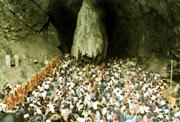Huong San, Vietnam
As soon as Tet is overand the lunar new year has begun, pilgrims head to Huong (Perfume) Pagoda for one of the biggest and most important events on the Buddhist calendar.

During the two-month-long festival, the sheer numbers of pilgrims making their way up the Huong Son mountain range make it almost impossible to recapture the serenity that has inspired generations of poets, including one of the Trinh warlords, to extol the area’s celestial beauty.
However, the crowds are not enough to drive away Quan Am (also known in Chinese as Kuan Yin or in Sanskrit as Avalokiteshivra), the bodhisattva of compassion who is believed to bless the pilgrims with happiness, children and wealth in the new year.
According to legend, Huong Son is home to many traces left by Quan Am during her lifetime; before she attained nirvana, transcended karma and extinguished desire, hatred and illusion.
The importance of the sacred site is enhanced by its unique combination of nature and culture: where rugged limestone mountains, caves and rivers meet centuries-old architecture.
Throughout the first few lunar months, thousands of visitors from across the country arrive at the Duc Khe wharf in Ha Tay Province’s My Duc District, 60km from Ha Noi, before they tackle the mountains by boat or on foot.
The less-popular trekking option would take the pilgrims through famous groves of apricots and allow them to meet villagers picking medicinal herbs or gathering kindling at the foot of the mountain range. They would also pass by the grave of the early 20th-century poet Tan Da.
The favoured boat trip along the scenic Yen Stream allows the pilgrims to hear first-hand accounts of the land and people of the area from those who know it best: the rowers.
The boat rowers would also advise their passengers about whether they should ascend straight to the Huong Tich Cave, spend some time at the nearby pagodas or continue along the stream to less-visited pagodas off the beaten path.
The rowers from Yen Vi Village would recount time and again how the goddess of compassion chose the mountain range, and how the emperors themselves had picked the spots for the pagodas and temples.
Every now and again, the rowers would slow down to point out the distant mountains shaped like a pile of rice, turtle, unicorn, phoenix or bells.
As soon as the visitors arrive at the Thien Tru Pagoda, the path gets steeper and narrower, and the traffic jams of the city come to the mountains.
The 12km climb to the Huong Tich Cave can take several hours, as the small winding path becomes a gridlocked chain of Buddhist pilgrims, hemmed in on both sides by make-shift stalls selling food, drinks and religious memorabilia.
Click to enlarge
Circle work: Villagers from Yen Vi perform dragon dances at the Thien Tru Pagoda to mark the beginning and end of the two-month-long Huong Pagoda Festival. — VNA/VNS Photos Trong Duc
Belly of the beast: The opening of the Huong Tich Cave is traditionally likened to the mouth of a dragon. It is the most significant site in the Huong Son mountains. — VNR Photo
The sound of old women chanting the mantra of nam mo a di da phat, or in the name of the Amitabha Buddha, can sometimes be heard over the bitter complaints of young couples carrying their kids on their backs.
This experience is often enough to make many people swear they will never make another pilgrimage to Huong Pagoda, but the next year they find themselves taking the trek all over again.
"All is suffering," joked one Hanoian who had just returned from a day at the pagoda. "That’s what a festival is all about."
The reward comes when the pilgrims finally reach the mountain that is home to the Huong Tich Cave – the main attraction in the range.
The cave is likened to the open mouth of a giant dragon, and the stalactites and stalagmites inside lead many to believe they are in a miniature pavilion.
Above the entrance to the cave is where the 18th-century poet and warlord Trinh Sam inscribed the words Nam thien de nhat dong, or "the most beautiful cave under the southern sky".
The large stalagmite in the middle of the cave is kept continuously wet by a trickle of water from the ceiling, and has long been thought to bring fertility to childless couples.
Women will rub their hands on the stalagmite in the hope of conceiving a child in the new year, and the fact that many couples have been blessed with a bundle of joy after visiting Huong Pagoda has added to the area’s mythology.



